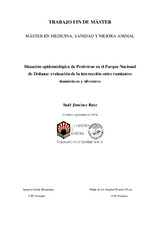Situación epidemiológica de Pestivirus en el Parque Nacional de Doñana: evaluación de la interacción entre rumiantes domésticos y silvestres
Autor
Jiménez-Ruiz, Saúl
Tutor
García-Bocanegra, IgnacioRisalde, M.A.
Editor
Universidad de CórdobaFecha
2018Materia
PestivirusSeroprevalencia
Interfaz
Rumiantes silvestres
España
Seroprevalence
Interface
Wild ruminants
Spain
METS:
Mostrar el registro METSPREMIS:
Mostrar el registro PREMISMetadatos
Mostrar el registro completo del ítemResumen
En la Península Ibérica se ha descrito una amplia variedad de escenarios epidemiológicos en relación a los Pestivirus (familia Flaviviridae) de rumiantes, Virus de la Diarrea Vírica Bovina -VDVB- y Virus de la Enfermedad de la Frontera -VEF- en poblaciones de rumiantes domésticos y silvestres. Sin embargo, la información relativa al papel de los rumiantes silvestres como reservorios naturales de los Pestivirus en los ecosistemas mediterráneos sigue siendo muy limitada. Durante los meses de octubre y noviembre de 2015 se obtuvieron muestras de suero de 138 bovinos mantenidos en extensivo en el Parque Nacional de Doñana (PND), así como muestras de 101 ciervos (Cervus elaphus) y 102 gamos (Dama dama) que comparten hábitat con el ganado bovino analizado. La presencia de anticuerpos específicos frente a la proteína p80 de Pestivirus se evaluó mediante ELISA de bloqueo (bELISA) y tests de seroneutralización vírica (TSV) (cepas VDVB-1, VDVB-2 y VEF-4). Todas las muestras de suero se analizaron para detectar la presencia de ARN de Pestivirus mediante RT-PCR. El 2,2% (3 de 138) de los bovinos analizados fueron positivos a ELISA y TSV (mayores títulos frente a VDVB-1) mientras que todos los rumiantes silvestres resultaron seronegativos. No se detectó ARN vírico en ninguna de las muestras de suero analizadas. La prevalencia obtenida indica una limitada circulación de Pestivirus en el ganado bovino en la zona de estudio así como la ausencia de circulación en los rumiantes silvestres analizados. Los resultados sugieren que los rumiantes silvestres no representan actualmente un riesgo en la transmisión de Pestivirus para el ganado en el PND. Sin embargo, la presencia de poblaciones no protegidas podría favorecer la aparición de brotes y animales persistentemente infectados tras la introducción de un Pestivirus en el PND. In the Iberian Peninsula a wide range of epidemiological contexts has been described in relation to the ruminant Pestivirus (Flaviviridae family), such as the Bovine Viral Diarrhoea Virus -BVDV- and the Border Disease Virus -BDV- in domestic and wild ruminant populations. However, the information of the wild ruminants‟ role as natural reservoirs of Pestivirus in Mediterranean ecosystems is still limited. During the months of October and November 2015, serum samples were obtained from 138 extensive cattle from Donana National Park (DNP), as well as samples from 101 deer (Cervus elaphus) and 102 fallow deer (Dama dama) sharing habitat with the analyzed cattle. The presence of specific antibodies against p80 protein of Pestivirus was evaluated by using both blocking ELISA (bELISA) and serum neutralization tests (SNT) (BVDV-1, BVDV-2 and BDV-4 strains). All serum samples were analyzed in order to detect the presence of Pestivirus RNA by RT-PCR. A 2.2% (3 out of 138) of the tested cattle was positive to both bELISA and SNT (higher titers against BVDV-1) while all wild ruminants were seronegative. No viral RNA was detected in any of the analyzed serum samples. The obtained prevalence indicates a limited widespread of Pestivirus in cattle inside the studied area, as well as the absence of viral circulation in the wild ruminants performed. The results suggest that currently, wild ruminants do not represent a risk of Pestivirus transmission for livestock in DNP. However, the presence of naïve populations may favor the appearance of outbreaks and persistently infected animals after the introduction of a Pestivirus in the DNP.
Descripción
Premio extraordinario de Trabajo Fin de Máster curso 2015-2016. Medicina, Sanidad y Mejora Animal

